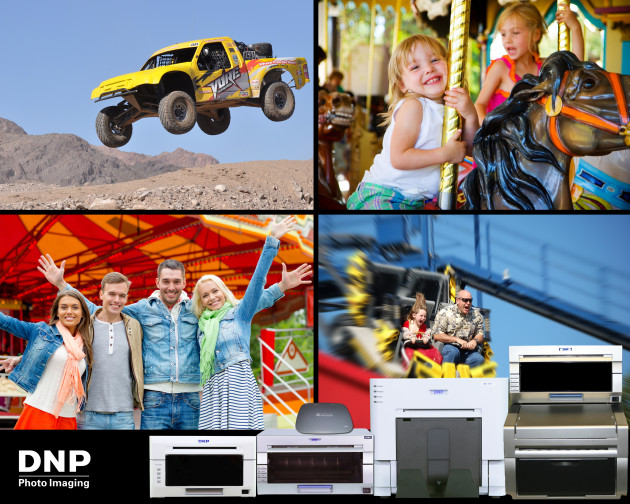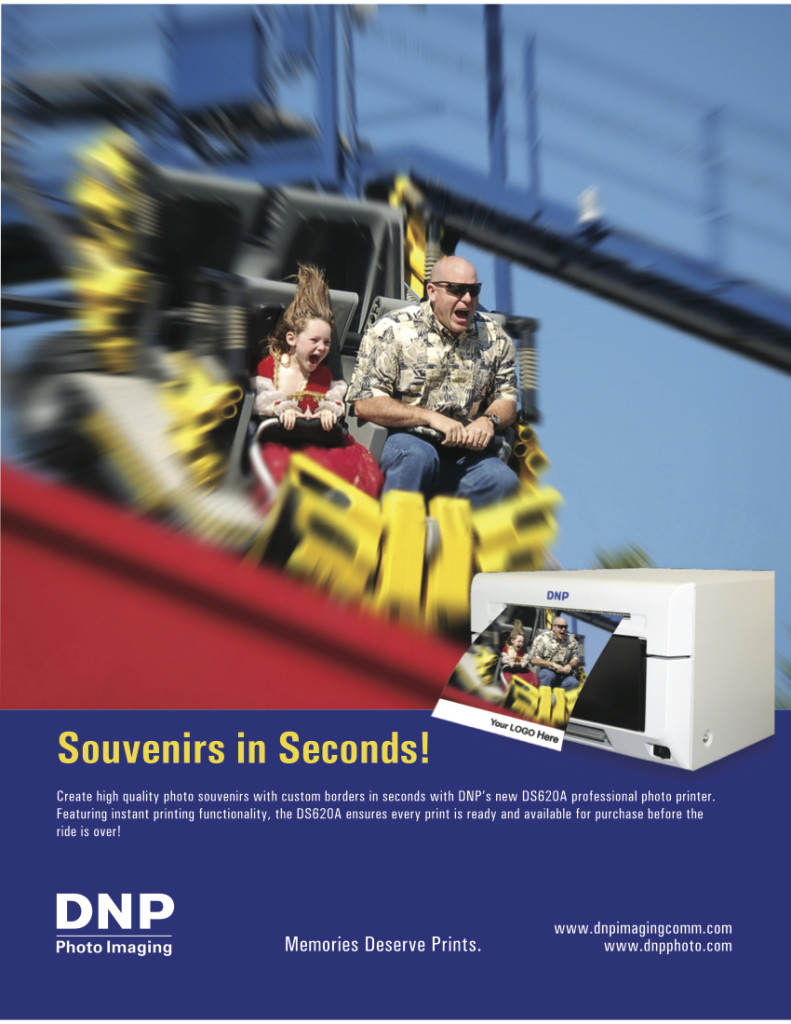Ways to integrate photo sales opportunities into your attraction • by Belinda LoPresti
[dropcap color=”#888″ type=”square”]H[/dropcap]igh quality printed images with a branded custom border or folder/frame are still among the best-selling souvenir items at parks around the world.
As the attractions industry continues to grow, park owners and operators face an array of challenges to ensure continued profitability. Finding ways to proactively generate new revenue streams while simultaneously enhancing the customer experience is critical. You may be surprised to learn that even in this digital age, in-park photography services can be a profit center.
The In-Park Photography Landscape

Offering park-wide photography services that include printed images has proven to be largely effective and popular with customers. Photo technologies such as green screens and augmented reality provide a tangible product that can’t be produced on a smartphone or standard point-and-shoot camera; and are vastly superior to the quality of a smartphone image.
Although accessing and sharing digital images is easier than ever before, the value of a physical print is still high. People still want prints to display in their homes.
Both digital and printed images have value to park visitors and can be part of attraction souvenir packages, but the digital image has a lower perceived value than a print, and consumers are willing to pay more for a high-quality printed image. Recently, the Vegas Off-Road Experience saw a 10 percent increase in revenue in the nine months following the deployment of a single photo printer.
Beyond the ride photo: 6 photo ops to have in your park
1. Designated Photo Spots: Have an area pre-scouted and designated to ensure park visitors will get a great shot—whether in front of a popular ride or landmark, or fronting an awesome view. Stationing a photographer with professional equipment there will allow guests to step out from behind their own capture devices and all get into the picture.
2. Haunted Attractions and Seasonal Events: Capture the thrills, shrieks, and scares of park-goers by adding a photo system to haunted attractions, Christmas fairs and other seasonal events.
3. Green Screen Photos: Entice guests with photo ops that let them pose against a themed backdrop, with a character or an exotic background, using a green screen. Don’t forget to include park branding!
4. Mascot Photos: Get your park mascots out and about the grounds or at a designated area for photos with families and kids of all ages.
5. Roaming Photographers: Photographers roaming the park are a great way to offer more professional shots and prints that guests can’t get on their smartphones and get everyone into the shot.
6. Entry Gate Photos: As soon as your guest comes through the gate, offer the option to take their photo, print it, and have it ready for them to take home on their way out. It will help them remember the good feelings of anticipation and arrival.
Impulse buys, repeat visitation and branding
A photo captures the emotion of a moment, and the park photo souvenir serves as a reminder of positive experiences and feelings. The photo souvenir package that guests take home as a personal memento helps reinforce the kind of emotional bond that can lead to repeat visits.
Just as a shopper might purchase a candy bar at the checkout aisle of a supermarket, park-goers will make spur-of-the-moment purchase decisions in theme parks. Some parks find that it pays to print photos on spec. They drive sales by having prints on display and ready for purchase immediately after the guest exits the ride. Short wait times and easy traffic circulation in the retail area will increase the chances of a sale.
Branded prints with a park logo or custom borders and folders are among the most popular items sold at attractions around the world. Branding a print increases the exposure of the park’s brand and is a great way to showcase the experience to prospective guests who will see the photos in people’s homes.
The case for dye-sublimation
The technology behind producing printed packages is just as important as the capture device in protecting quality, guest satisfaction and profit margins.
The two most widely used photo printing methods available are inkjet and dye-sublimation. Inkjet printers spray droplets of ink onto specially coated papers. Dye-sub printers use a dry technique that diffuses dye onto paper. This dye comes in the form of a ribbon, which is converted into a gas by a heated print head that is absorbed by a special receiving layer on the paper.
In our experience, dye-sublimation printing offers several advantages for park operators, including high margins, low maintenance, and speed. Cashman Photo, the leading photo providers at attractions across Las Vegas, recently upgraded its wet-print labs with dye-sublimation dry print solutions—citing the total cost of ownership from an energy, media, and operational standpoint as significantly lower than their previous wet labs. High quality dye-sublimation systems are also said to be robust, able to turn out prints in a wide range of sizes, and compact enough to readily fit photo booths and concessions.
When it comes to printing with dye-sublimation, since there are no expensive ink cartridge refills, the price per print is the price per print. Dye-sublimation media prices (paper and ribbon) generally don’t fluctuate and are usually good for hundreds of prints in a single roll.
Park operators need to be able to produce prints quickly while guests’ interest level is high. Dye-sublimation printers can print full-bleed customized images in a matter of seconds. Prints are dry and ready to touch as soon as they leave the printer. Dye-sublimation prints are also resistant to fingerprints, dust and fading, and typically are available in glossy or matte finishes.
The bottom line
Park visitors take thousands of photos on their smartphones every day, but often have no way of viewing them off-screen and are not printing at home at the same rate they were even a few years ago. For the attractions industry, print photography continues to represent a major opportunity to improve the bottom line. • • •
Belinda LoPresti is Director of Marketing, DNP Imagingcomm America Corporation (www.dnpphoto.com)







